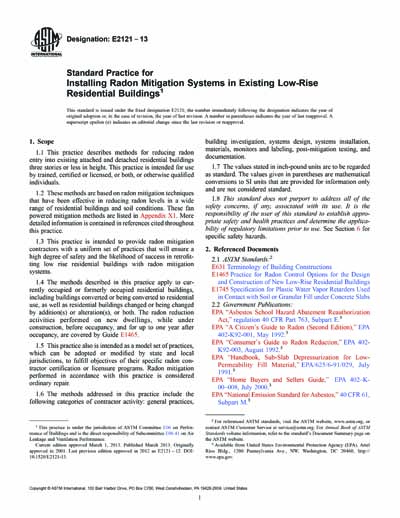Historical
ASTM E2121-13
Standard Practice for Installing Radon Mitigation Systems in Existing Low-Rise Residential Buildings
1.1 This practice describes methods for reducing radon entry into existing attached and detached residential buildings three stories or less in height. This practice is intended for use by trained, certified or licensed, or both, or otherwise qualified individuals.
1.2 These methods are based on radon mitigation techniques that have been effective in reducing radon levels in a wide range of residential buildings and soil conditions. These fan powered mitigation methods are listed in Appendix X1. More detailed information is contained in references cited throughout this practice.
1.3 This practice is intended to provide radon mitigation contractors with a uniform set of practices that will ensure a high degree of safety and the likelihood of success in retrofitting low rise residential buildings with radon mitigation systems.
1.4 The methods described in this practice apply to currently occupied or formerly occupied residential buildings, including buildings converted or being converted to residential use, as well as residential buildings changed or being changed by addition(s) or alteration(s), or both. The radon reduction activities performed on new dwellings, while under construction, before occupancy, and for up to one year after occupancy, are covered by Guide E1465.
1.5 This practice also is intended as a model set of practices, which can be adopted or modified by state and local jurisdictions, to fulfill objectives of their specific radon contractor certification or licensure programs. Radon mitigation performed in accordance with this practice is considered ordinary repair.
1.6 The methods addressed in this practice include the following categories of contractor activity: general practices, building investigation, systems design, systems installation, materials, monitors and labeling, post-mitigation testing, and documentation.
1.7 The values stated in inch-pound units are to be regarded as standard. The values given in parentheses are mathematical conversions to SI units that are provided for information only and are not considered standard.
1.8 This standard does not purport to address all of the safety concerns, if any, associated with its use. It is the responsibility of the user of this standard to establish appropriate safety and health practices and determine the applicability of regulatory limitations prior to use. See Section 6 for specific safety hazards.
Content Provider
ASTM International [astm]






